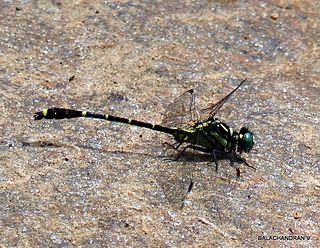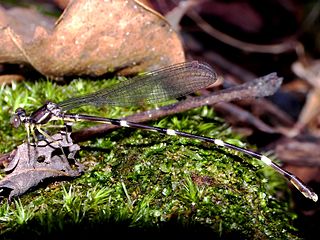| Acrogomphus | |
|---|---|
| Scientific classification | |
| Domain: | Eukaryota |
| Kingdom: | Animalia |
| Phylum: | Arthropoda |
| Class: | Insecta |
| Order: | Odonata |
| Infraorder: | Anisoptera |
| Family: | Gomphidae |
| Genus: | Acrogomphus Laidlaw, 1925 [1] |
Acrogomphus is a genus of dragonfly.
| Acrogomphus | |
|---|---|
| Scientific classification | |
| Domain: | Eukaryota |
| Kingdom: | Animalia |
| Phylum: | Arthropoda |
| Class: | Insecta |
| Order: | Odonata |
| Infraorder: | Anisoptera |
| Family: | Gomphidae |
| Genus: | Acrogomphus Laidlaw, 1925 [1] |
Acrogomphus is a genus of dragonfly.
The following species are recognized in this genus: [1]

The chasers, darters, skimmers and perchers and their relatives form the Libellulidae, the largest family of dragonflies. It is sometimes considered to contain the Corduliidae as the subfamily Corduliinae and the Macromiidae as the subfamily Macromiinae. Even if these are excluded, there remains a family of over 1000 species. With nearly worldwide distribution, these are almost certainly the most often seen of all dragonflies.

The Gomphidae are a family of dragonflies commonly referred to as clubtails or club-tailed dragonflies. The family contains about 90 genera and 900 species found across North and South America, Europe, Asia, Australia, and Africa. The name refers to the club-like widening of the end of the abdomen. However, this club is usually less pronounced in females and is entirely absent in some species.

The Platycnemididae are a family of damselflies. They are known commonly as white-legged damselflies. There are over 400 species native to the Old World. The family is divided into several subfamilies.

Agriocnemis is a genus of damselfly in the family Coenagrionidae. Agriocnemis is distributed widely across Africa, South-east Asia, Indonesia, Australia and islands in the Pacific. They are small insects, commonly known as wisps.

Burmagomphus is a genus of dragonfly in the family Gomphidae. It contains the following species:

Ceriagrion is a genus of damselfly in the family Coenagrionidae. Species of Ceriagrion are small to medium size, generally brightly coloured damselflies. They are found across the Old World, Africa, Asia and Australia.

Gynacantha is a genus of dragonflies in the family Aeshnidae. The females have two prominent spines under the last abdominal segment. This gives the genus name and the common name two-spined darners; they are also known as duskhawkers.

Heliogomphus is a genus of dragonflies in the family Gomphidae.
Leptogomphus is a genus of dragonfly in the family Gomphidae. It contains the following species:

Mortonagrion is a genus of damselfly in the family Coenagrionidae. It contains the following species:

Onychogomphus is a genus of dragonflies in the family Gomphidae. They are commonly known as pincertails.

Prodasineura, the Asian threadtails, is a genus of damselflies in the family Platycnemididae. All the Afrotropical species formerly in this genus are now placed in Elattoneura, the African threadtails. Dijkstra et al. (2014) moved the genus from Protoneuridae to Platycnemididae based on molecular phylogenetic research.

Rhinocypha is a genus of damselflies in the family Chlorocyphidae.

Teinobasis is a genus of damselflies in the family Coenagrionidae. Species occur in south-eastern Asia, Indonesia, Solomon Islands and Micronesia; one species, Teinobasis rufithorax, is found in Australia.

Vestalis is a genus of damselflies belonging to the family Calopterygidae.

Libellago is a genus of damselflies in the family Chlorocyphidae. Species in the genus are found mainly in Southeast Asia.

Coeliccia is a genus of damselflies in the family Platycnemididae. They are distributed in Asia from India to Japan to Indonesia. It is the largest genus in the family, with around 80 species.
Metaphya is a genus of dragonfly in the family Corduliidae. Metaphya are found in Asia, New Guinea, Australia, Indonesia and parts of the Pacific region.

Protosticta is a genus of shadowdamsel in the damselfly family Platystictidae. There are more than 50 described species in Protosticta.